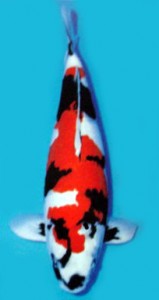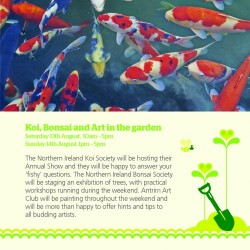Showa
 Showa – the third of the Go-Sanke varieties and the last one to be developed. This variety was produced by Mr. Hoshino in the Takezaua district in Niigata in 1927 by crossing a Kohaku with a Ki Utsuri. Further development, particularly by a Mr. Kobakyashi, to improve the Hi colour lead to the Showa as we know it today being produced in the early 1960’s. In terms of breeding true to type, this is the least reliable of the big three varieties, making good quality Showas uncommon. It is estimated that only about 20% of the offspring of Showa will in fact be Showa. Add to this, the fact that they are also unpredictable in the changes which take place during their growth and one can begin to understand why good Showa are rare.
Showa – the third of the Go-Sanke varieties and the last one to be developed. This variety was produced by Mr. Hoshino in the Takezaua district in Niigata in 1927 by crossing a Kohaku with a Ki Utsuri. Further development, particularly by a Mr. Kobakyashi, to improve the Hi colour lead to the Showa as we know it today being produced in the early 1960’s. In terms of breeding true to type, this is the least reliable of the big three varieties, making good quality Showas uncommon. It is estimated that only about 20% of the offspring of Showa will in fact be Showa. Add to this, the fact that they are also unpredictable in the changes which take place during their growth and one can begin to understand why good Showa are rare.
It goes without saying that good body shape and skin quality are a prerequisite in the search for quality in this variety. Showa are generally referred to as a black Koi with red & white markings, as opposed to Sanke which are white fish with red & black markings. It is, however, hard to think of many of today’s Showa in these terms due to the black not being as much in evidence as in earlier times, and many Showa having large areas of white. However, it is generally not difficult distinguish between Showa and Sanke, but more of this later.
The Hi pattern is basically that of Kohaku except that the head marking may, in the case of Showa, spread to cover the eyes, nose and cheeks; although some white on the head is desirable. Good, clearly defined, large Hi marking of uniform colour are important. Showa whose red markings are continuous from head to tail are called Hi Showa and although popular are said by the purists to lack refinement, possibly due to the absence of white skin.The white pattern should be pure in colour without staining to set off the Hi and Sumi. Pure white is less easily found in Showa than in Kohaku or Sanke and is therefore to be greatly admired. An area of about 20% white on the body is said to be the ideal.
As with all these rules, there is the exception; Kindai Showa being predominantly white.The sumi of Showa is perhaps the most important of the three colours and should be a solid dense black; Sumi on the head being particularly important. The division of the head with Sumi is called Menuare and is the traditional head pattern. However the alternative of a V shaped marking across the back of the head, sometimes with a further central marking running down towards the nose to form a Y shape is a more modern pattern which clearly defines the head. There are endless possibilities between these two styles. Too much Sumi on the head gives an unbalanced look to the Koi and is to be avoided. The body Sumi markings should be large and bold. The contrast between them and the white and red gives Showa its sense of power.
The Japanese have described the Sumi of Showa as mountain-shaped which is an apt description. The Sumi should also extend below the lateral line and give the appearance of wrapping the body. The other important area of Sumi is in the pectoral fins which should be black at the base radiating out to about one third of the fins. The feature is called Motoguro. Evenness of Motoguro on both pectoral fins is sought after as a sign of quality. The sumi of Showa also often runs into the tail and dorsal fins but there should he no Hi staining on these fins.To distinguish between Showa and Sanke is generally not dificult although the occasional query Koi does crop up. The distinguishing features between the two are that Showa have head sumi whilst Sanke does not; Showa also have Motoguro in the pectoral fins as opposed to stripes in Sanke. The body sumi extends below the lateral line in Showa whilst in Sanke it lies on the back with generally smaller markings. Also, the actual appearance of the sumi is quite different to the practiced eye.
Other variations on the Showa theme include: Kage Showa, meaning shadowed; the white of which has a blurred reticulated sumi pattern but should still retain the solid red and black markings. Koromo Showa on which the reticulated sumi markings appear on the red pattern. Kanoko Showa on which the Hi markings are dappled – good specimens of this variety are extremely rare. Metallic Showa are either Gin or Kin Showa; the Gin version having a silver lustre and the Kin version a gold lustre. Doitsu, Ginrin and Tancho varieties are also available. As with all patterned varieties it is the overall balance and harmony of the individual colours which are of the essence, this being especially true of the fascinating variety that is Showa.
